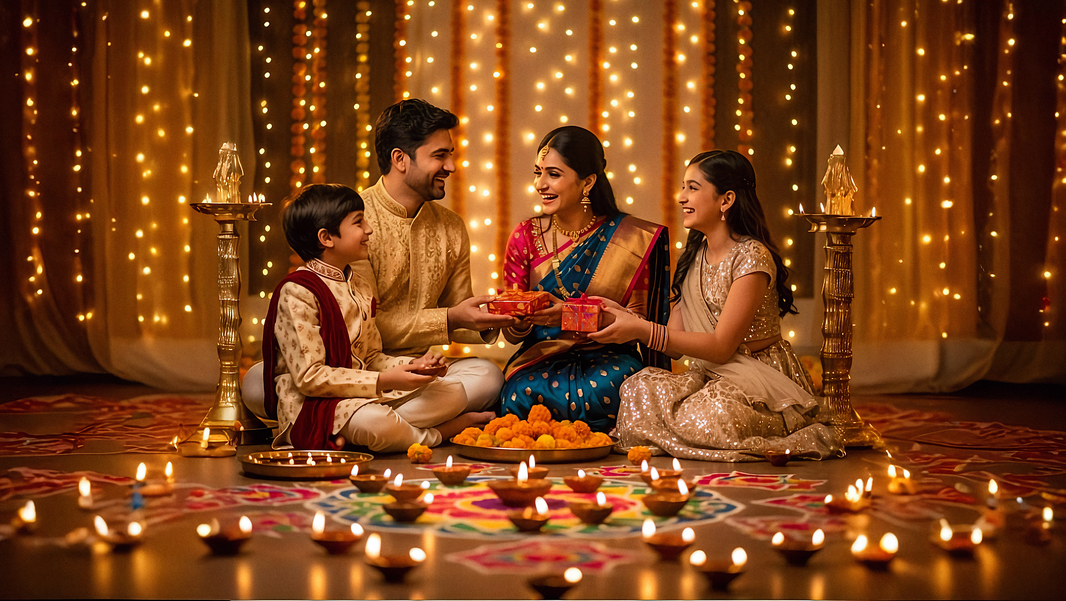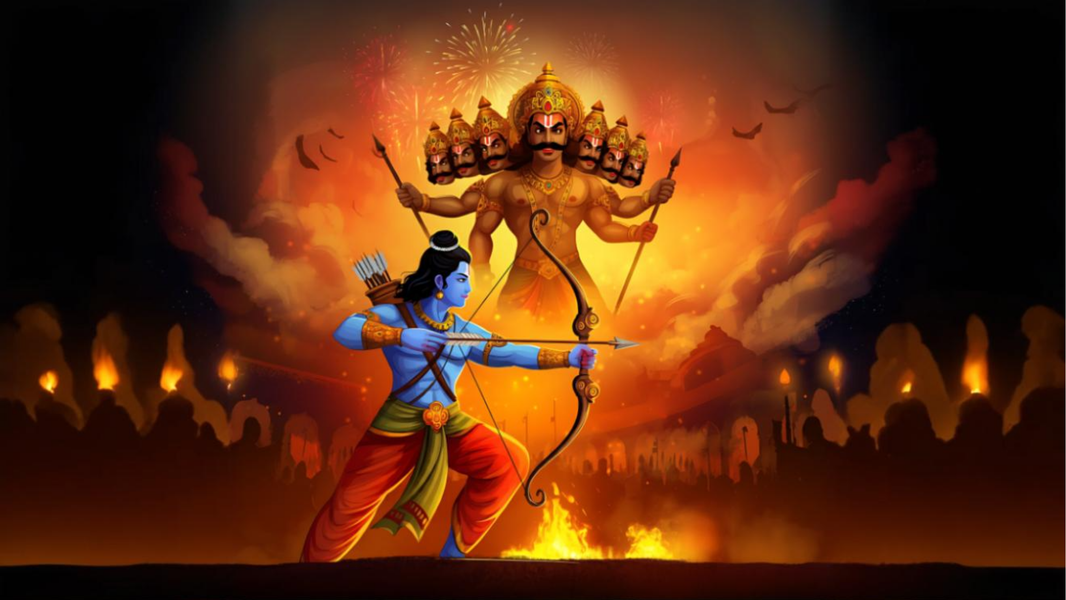Navratri, which literally means “nine nights”, is one of the most vibrant and spiritually uplifting festivals in India. Across these nine days and nights, devotees honor Maa Durga and her nine divine forms, collectively known as Navadurga.
Sharad Navratri 2025 will be celebrated from September 22 (Monday) to September 30 (Tuesday). These auspicious days are dedicated to invoking the strength of the Goddess, symbolizing the victory of good over evil, and celebrating the divine feminine energy, or Shakti.
But Navratri is more than rituals; it is a journey of discipline, devotion, joy, and self-purification. From the colors we wear to the food we prepare, each aspect holds a deeper spiritual meaning. Let’s explore the origins, significance, daily rituals, and the beautiful traditions that make Navratri 2025 so special.
Origin and Significance of Navratri
At the heart of Navratri lies the timeless tale of Maa Durga and Mahishasura. Mahishasura, a mighty demon blessed with near invincibility, wreaked havoc across the worlds. The gods, unable to defeat him, invoked the combined energy of the divine trinity; Brahma, Vishnu, and Shiva. From this radiance emerged Maa Durga, the embodiment of feminine power, riding a lion and wielding celestial weapons. After a fierce nine-day battle, she vanquished Mahishasura, restoring peace and order.
Each of Navratri’s nine days is dedicated to one of Maa Durga’s forms; collectively called the Navadurga. These goddesses symbolize qualities such as courage (Shailaputri), wisdom (Brahmacharini), grace (Chandraghanta), energy (Kushmanda), nurturing love (Skandamata), discipline (Katyayani), protection (Kalaratri), compassion (Mahagauri), and fulfillment (Siddhidatri).
Spiritually, Navratri is seen as a period of inner cleansing. It encourages devotees to let go of negativity and embrace virtues that lead to peace, balance, and growth.
Navratri Rituals
Rituals during Navratri connect the external acts of devotion with inner spiritual growth. Some of the most common include:
-
Kalash Sthapana (Ghatsthapana): The ceremonial beginning, where a sacred pot is installed as a symbol of Maa Durga’s presence. It is filled with water, topped with mango leaves and a coconut, and worshipped throughout the nine days.
-
Fasting Traditions: Devotees observe fasts in different forms; fruit-only diets, milk and water fasts, or light sattvik meals. The practice is less about denial and more about purifying the body and mind.
-
Daily Puja: Lighting an oil lamp, offering fresh flowers, reciting Durga Saptashati, and meditating on the day’s goddess form are central practices.
-
Prasad/Bhog: Sacred food offerings made with devotion, later shared as blessings with family and community.
-
Kanya Pujan: On the eighth or ninth day, young girls (symbolizing the nine goddesses) are worshipped and offered prasad, gifts, and respect.
Tip: Keep your puja area clean and decorated with fresh flowers. A calm environment helps deepen your devotion.
Navratri Color 2025
One of the most joyful traditions of Navratri is wearing a different colour each day. Each day, devotees across the country dress in hues that reflect the energy of the Goddess being worshipped. Homes, streets, and temples light up with these shades, creating a moving tapestry of devotion and joy. These colors are not just aesthetic choices; they hold symbolic meanings and are believed to attract divine blessings. Here’s what each day brings to life in 2025:
-
Day 1 (Sept 22, Monday) – White: The festival begins with purity. White captures the serene energy of Goddess Shailputri, setting the tone for fresh beginnings and a peaceful heart. Imagine starting your Navratri with prayers as crisp as the morning dew, wrapped in the stillness of white.
-
Day 2 (Sept 23, Tuesday) – Red: As energy builds, red takes over. Symbolizing strength and vitality, this day honors Brahmacharini. It’s the passionate shade of life itself; like the first spark that turns devotion into determination.
-
Day 3 (Sept 24, Wednesday) – Royal Blue: A regal calm arrives with Royal Blue, reflecting Goddess Chandraghanta’s quiet yet commanding presence. This colour feels like the calm ocean; deep, steady, and powerful beneath the surface.
-
Day 4 (Sept 25, Thursday) – Yellow: Joy blooms in yellow, the colour of wisdom and light. Dedicated to Kushmanda, it’s said that she created the world with her smile. On this day, the sun feels warmer, and your heart a little lighter.
-
Day 5 (Sept 26, Friday) – Green: Navratri enters its nurturing phase with Goddess Skandamata. Green radiates harmony and growth; think of new leaves on a branch, soft yet strong, promising abundance.
-
Day 6 (Sept 27, Saturday) – Grey: Subtle yet steady, grey represents Goddess Katyayani. It’s a shade of discipline and inner balance; reminding us that even in vibrancy, restraint is divine.
-
Day 7 (Sept 28, Sunday) – Orange: A burst of courage arrives with Goddess Kalaratri. Orange is fire; warm, daring, and transformative. It feels like standing in the glow of diyas as chants rise louder in devotion.
-
Day 8 (Sept 29, Monday) – Peacock Green: The festival’s beauty deepens with Goddess Mahagauri. Peacock Green blends compassion with elegance, evoking both grace and strength; like the iridescent shimmer of the peacock’s feather.
-
Day 9 (Sept 30, Tuesday) – Pink: Navratri closes with the gentle embrace of pink. Dedicated to Siddhidatri, it is the color of love, kindness, and divine blessings; filling hearts with hope as devotees prepare for new beginnings.
How you can practice: Even if you can’t dress in full attire, consider wearing a scarf, bracelet, or accessory in the day’s color. It’s a simple way to stay connected to the rhythm of the festival.
Your Day-by-Day Navratri 2025 Guide
Navratri is more than just nine days of rituals; it’s a journey of devotion, color, and stories that connect us back to the Divine Mother. Each day honors a different form of Goddess Durga, with its own traditions, emotions, and flavors that bring families together. Here’s how you can celebrate at home this year:
Day 1 – Shailaputri (Sept 22)
The first day begins with Kalash Sthapana, a sacred invocation that marks the start of the festival. Shailaputri, the daughter of the Himalayas, represents strength and grounding. Families often begin the day by offering white flowers and chanting her mantras. The prasad; suji halwa or pongali; fills the home with a sweet aroma, setting a tone of warmth and hope for the days to come.
Day 2 – Brahmacharini (Sept 23)
On this day, the Goddess is worshipped as the symbol of devotion and wisdom. The rituals are kept simple, reflecting her austere penance. Many offer mishri or sugar, symbols of her purity. The food is light, tamarind rice or sweet mishri-based treats; reminding us that simplicity can also be deeply nourishing.
Day 3 – Chandraghanta (Sept 24)
Chandraghanta is depicted with a bell-shaped crescent moon on her forehead, and so, ringing a ghanta (bell) during the puja becomes a central ritual. It is believed to clear negativity and invite peace into the home. Families prepare coconut rice or kheer, dishes that carry a sense of festivity and comfort, often shared joyfully among neighbours and guests.
Day 4 – Kushmanda (Sept 25)
Worshipping Kushmanda is like invoking the energy of creation itself. Her blessings are sought with bright marigold garlands, and chants of “ॐ देवी कूष्माण्डायै नमः” fill the space with vibrance. Kitchens come alive with the frying of malpua or the savoury crunch of lentil fritters, filling homes with the sound of laughter and the smell of festivity.
Day 5 – Skandamata (Sept 26)
The fifth day is devoted to Skandamata, the nurturing mother of Kartikeya. Devotees offer bananas, a symbol of nourishment and care. Families gather around plates of poha with banana and jaggery, a dish that feels both homely and festive. It is a day to cherish the protective love of the Divine Mother and the bonds within one’s own family.
Day 6 – Katyayani (Sept 27)
This day celebrates the fierce and courageous form of the Goddess. Honey is offered during the puja, representing sweetness within strength. The prasad, often a honey-based halwa, beautifully captures this balance; soft yet powerful. It’s a reminder that discipline and compassion can walk hand in hand.
Day 7 – Kalaratri (Sept 28)
Kalaratri, the fiercest form of Durga, is worshipped for her protective energy. Many devotees light a diya that burns through the night, symbolizing her eternal vigilance against darkness. The evening prasad of lapsi, a sweet made from broken wheat, is hearty and wholesome, bringing families together to share stories late into the night.
Day 8 – Mahagauri (Sept 29)
The eighth day is one of purity and grace. Many households perform Kanya Pujan, inviting little girls as embodiments of the Goddess and serving them food with love. The offerings of coconut halwa are rich and festive, prepared with devotion. This day often feels like the heart of Navratri; soft, compassionate, and filled with blessings.
Day 9 – Siddhidatri (Sept 30)
The final day celebrates Siddhidatri, the granter of blessings and fulfillment. Devotees offer lotus flowers and meditate on their hopes for the year ahead. The prasad fruits, khichdi, or kheer; is simple yet deeply symbolic of completeness. It is a day of reflection, gratitude, and quiet joy, closing the nine-day journey with a sense of renewal.
Food & Prasad Traditions: Nourishing Body and Soul
Food plays a central role in Navratri. But it’s not about feasting; it’s about simplicity and purity.
-
Cook sattvik meals: Avoid onion, garlic, and heavy spices. Focus on fresh fruits, milk, grains like buckwheat or singhara flour, and light seasonings.
-
Daily prasad: Align your offering with the goddess of the day (as listed above). Preparing even a small dish with devotion is considered sacred.
-
Share with others: Offer prasad to family, neighbors, or even those in need. When shared, the blessings multiply.
Tip: If you’re fasting, plan your meals in advance. Keep light snacks like roasted makhana or fruits ready so that your energy remains stable throughout the day.
Conclusion: The Blessings of Navratri
Navratri 2025 is not just a festival; it is a soulful celebration of faith, discipline, and devotion. Each day reminds us of the power within, urging us to conquer negativity and embrace light.
From the symbolic colours to the sattvik foods, every ritual invites us to pause, reflect, and align with positivity. In today’s fast-paced life, Navratri serves as a grounding reminder: devotion and gratitude can guide us toward inner strength and harmony.
As families gather for prayers, communities dance to Garba and Dandiya, and kitchens fill with the aroma of sattvik prasad, the festival unites us in joy and reverence.
May Maa Durga’s blessings fill your life with health, prosperity, and wisdom this Navratri and always.







